Argentina Web3 Industry Report: A Digital Ark Amid the Inflation Tsunami
Argentina represents a significant real-world use case for cryptocurrency driven by economic necessity.
Author: Esther, IOSG
I. Introduction
The study of Argentina's Web3 industry stems from a fundamental premise: Argentina represents a significant, economically driven, and crucial real-world use case for cryptocurrency. Decades of ongoing economic instability—including nearly 300% hyperinflation and strict capital controls—have made stablecoins and decentralized assets vital financial safe havens for millions of citizens. This bottom-up, organically scaled adoption, combined with a world-class talent pool, has created a unique ecosystem. As such, Argentina serves as an invaluable living laboratory, helping us deeply understand how decentralized technologies can provide real utility and solve practical problems when facing urgent social and economic challenges.
Devconnect 2025
This report aims to provide forward-looking insights to the global Web3 community ahead of the Devconnect conference to be held in Buenos Aires in November 2025. By presenting Argentina’s market dynamics, world-class technical talent, and local community ecosystem, we strive to catalyze high-impact collaborations and precise resource matching.
This report is a key resource connecting international builders with a mature local ecosystem, aiming to accelerate the rollout of Web3 solutions across Latin America. We invite all developers, founders, and community leaders to connect and provide feedback, jointly driving regional growth.
II. How Cryptocurrency Rose in Argentina
Argentina’s Longstanding Economic Instability
Argentina’s economic narrative has always been accompanied by profound structural instability, with its national currency, the Argentine peso, enduring double-digit inflation rates for decades. This volatility peaked in April 2024, with inflation soaring year-on-year to 289.4%. Nevertheless, under President Javier Milei’s administration and its radical economic reforms (such as “shock therapy”), Argentina’s inflation and peso devaluation saw a significant decline between 2024 and 2025. By mid-2025, the annual inflation rate had dropped sharply, with data released in May 2025 showing a monthly inflation rate of 43.5%.
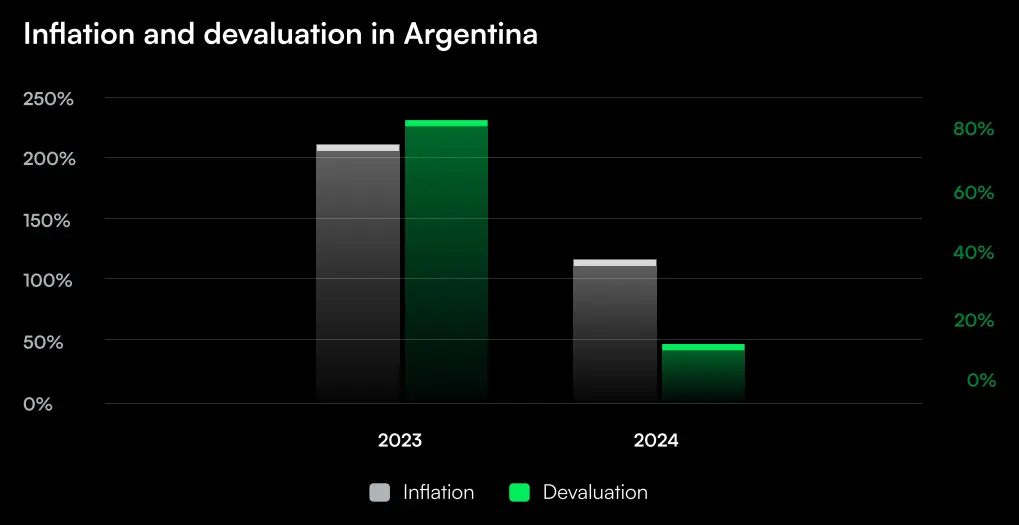
▲ cr. lemon.me
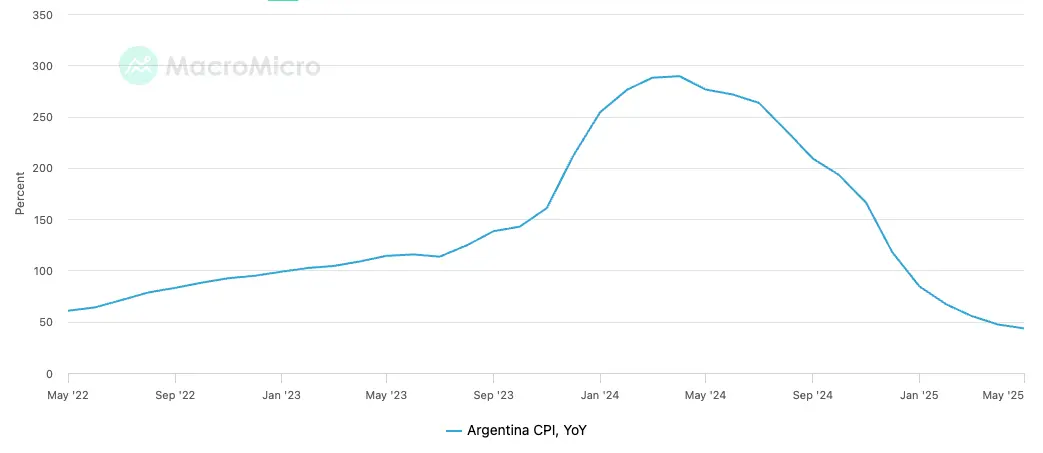
▲ cr. MacroMicro
Despite these initial successes, Argentina’s economic situation remains at double-digit inflation levels, with fundamentals still fragile. Ongoing currency devaluation has severely eroded people’s purchasing power and savings. More challenging still, the government’s strict capital controls and foreign exchange restrictions have historically locked Argentines out of traditional means of wealth protection, such as buying US dollars.
Cryptocurrency as a “Digital Safe Haven”
The 2001 “Corralito” crisis was a key historical event that continues to shape Argentina’s financial landscape. At that time, the government severely restricted access to bank accounts, leading to widespread distrust in traditional financial institutions and the government’s ability to safeguard private assets.
This historical context is the deep-seated driver behind the widespread adoption of decentralized financial tools such as cryptocurrency today. Memories of past asset seizures and interventions make the decentralized and censorship-resistant nature of cryptocurrency not just a technical feature but a fundamental attraction for many Argentines—it is seen as a reliable shield against state control and financial erosion. This deep-rooted distrust of the traditional financial system means that cryptocurrency adoption goes far beyond mere economic hedging.
In an environment of economic uncertainty and financial restrictions, cryptocurrency—especially stablecoins pegged to the US dollar—has become an essential practical financial safe haven for millions of Argentines. These digital assets provide a safer and more efficient alternative to the highly volatile peso, while also replacing the local underground currency exchange networks known as “cuevas.”
For individuals and businesses, cryptocurrency offers an asset channel to circumvent direct government controls, enabling cross-border payments and yield generation. This shift has made digital currencies not just investment tools but fundamental elements of daily financial survival, empowering Argentines with greater autonomy and stability in a challenging economic environment.
III. Scale of Cryptocurrency Adoption and Market Observations
Cryptocurrency Ownership and User Activity
Argentina is renowned globally for its high cryptocurrency ownership rate and active user participation. Between 2023 and 2024, about 18.9% of Argentines reported holding cryptocurrency, ranking the country fourth worldwide—surpassing Brazil (17.5%) and the United States (15.5%). Although other reports show slightly different figures (for example, a central bank study indicated nearly 12% ownership in 2023, and Triple A reported 5.6% for the same year), the overall trend shows a rapid and irreversible acceleration in cryptocurrency adoption between 2023 and 2024.
These statistical differences stem from varying survey methods and target populations (such as the general public versus internet users or specific exchange users), but the upward trend confirms the widespread penetration of cryptocurrency in Argentina. In January 2025, Coinbase officially entered the Argentine market after receiving regulatory approval, estimating that about 5 million people (out of a total population of 45.8 million) use digital assets daily, highlighting a large and active user base.
Platform data also confirms the growth in user engagement. According to leading Latin American crypto platform Bitso, its Argentine user base grew by 11% by the end of 2024 compared to 2023. The largest local platform, Lemon, had nearly 600,000 bitcoin holders by the end of 2024, accounting for 36% of its assets under custody in Argentina. Stablecoins accounted for 27%, and the Argentine peso made up 18% of holdings. In terms of trading volume, stablecoin trading grew by 44.4%, while bitcoin and altcoin trading volumes increased by 126% and 158.5%, respectively.
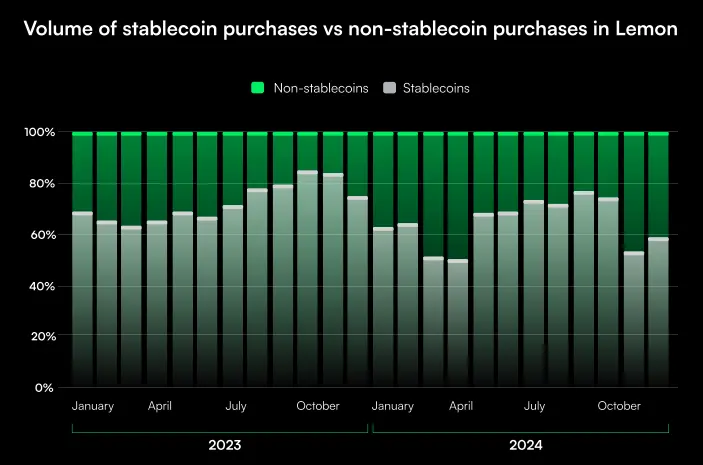
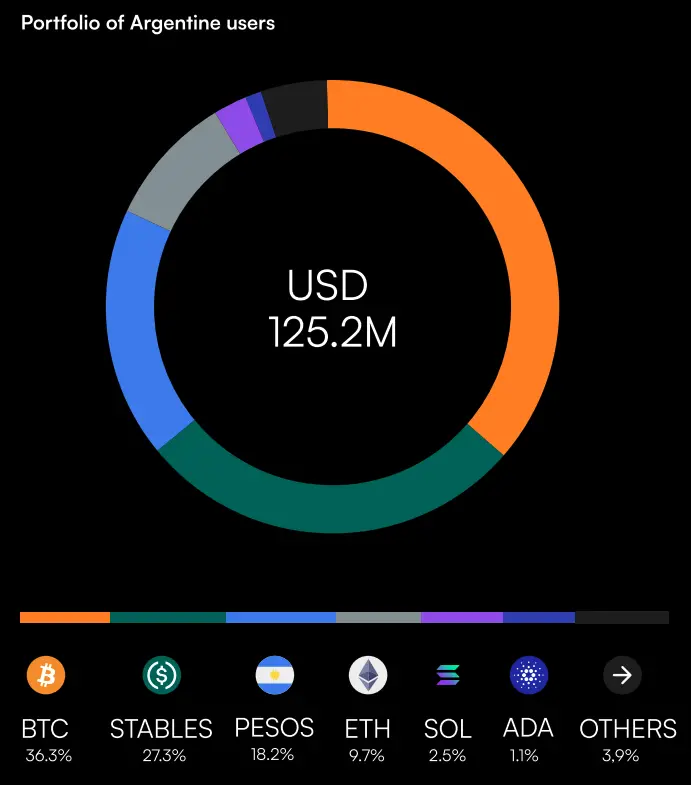
▲ cr. lemon.me
Similarly, demographic analysis reveals a trend toward a younger and more gender-balanced crypto community in Argentina. Across Latin America, 38% of crypto users are aged 25 to 34, consistent with global trends. Notably, participation among users aged 18 to 24 rose from 22% in 2023 to 23% in 2024.
Argentina shows a unique social trend in gender participation: female users increased by three percentage points to reach 31% in 2024, while males accounted for 69%, slightly above the global 70/30 ratio. The rise in female participation indicates that the practical benefits of cryptocurrency—especially as a hedge against economic turmoil—are breaking through traditional gender barriers in finance. This suggests that cryptocurrency is increasingly seen as a key tool for financial empowerment, with universal appeal crossing demographic boundaries.
Market Size and Activity
Argentina’s cryptocurrency market demonstrates significant activity and trading volume. According to Chainalysis, between July 2023 and June 2024, the country’s digital asset trading volume reached nearly $91 billion, up 6.7% year-on-year. This strong performance propelled Argentina to 13th place globally in crypto trading volume in 2024.
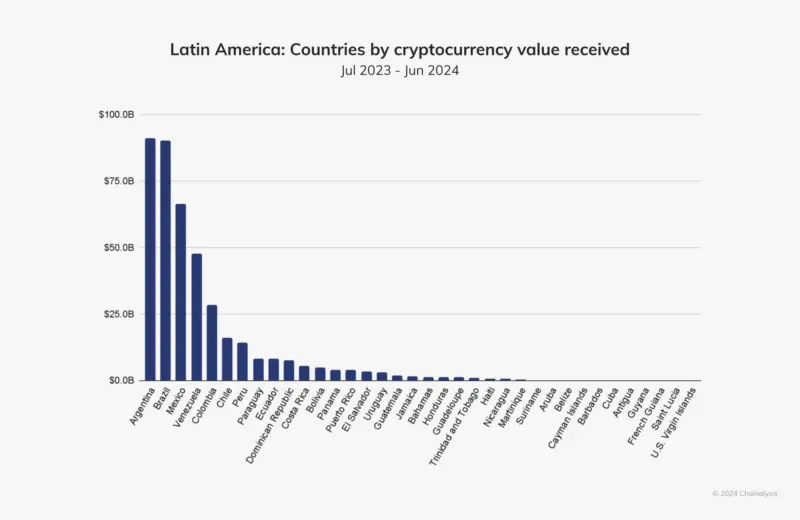
▲ cr. Chainalysis
Although Chainalysis’s public data does not detail monthly active user numbers, the high proportion of crypto holders (30% in 2024) and an estimated 5 million daily users indicate a large and highly engaged user base in Argentina.
Given Argentina’s historic informal financial markets and capital controls, the large trading volume and high adoption rate suggest that a significant portion of crypto activity occurs via peer-to-peer channels or decentralized exchanges. This behavior stems from the desire to avoid the formal financial system and government oversight. The pattern highlights a deeply ingrained behavioral adaptation: seeking alternative financial channels has become a common strategy for managing wealth and transactions.
Stablecoin-Dominated Digital Currency Adoption
While cryptocurrency is widely used, it is notable that stablecoins overwhelmingly dominate Argentina’s crypto sector. Between 2023 and 2024, stablecoins accounted for 61.8% of Argentina’s crypto trading volume, far above the global average of 44.7%. From Q3 2022 to Q2 2024, 31% of small retail transactions (<$1,000) in Argentina were completed using stablecoins, second only to Venezuela in the region.

▲ cr. Chainalysis
Argentines’ preference for specific stablecoins is also clear: in 2024, USDC and USDT together accounted for 39% of crypto purchases, up significantly from 30% in 2023. Bitget Latin America head Maximiliano Hinz described Argentina as an “anomalous market where many people buy USDT and don’t consider other options,” noting that this phenomenon is rare elsewhere.
Argentine users’ strong preference for stablecoins stems from several key factors:
-
Hedging Inflation and Currency Devaluation: Stablecoins, mainly pegged to the US dollar, provide a crucial and convenient hedge against the ongoing volatility of the Argentine peso.
-
Digital Convenience and No Purchase Limits: Before April 2024, Argentines were limited to buying only $200 per month, making it difficult to obtain and accumulate dollars. Stablecoins, as digital assets usable and exchangeable across devices, are generally not subject to such restrictions.
-
Efficiency and Low Fees: Compared to traditional remittance channels, stablecoins enable faster and more cost-effective cross-border payments.
The “anomalous phenomenon” of stablecoins dominating Argentina’s market reflects a unique behavioral pattern born of extreme economic conditions. This is not just about high stablecoin usage—it also signals a fundamental shift in monetary psychology: digital dollar-pegged assets are often more trusted and accessible than the national fiat currency or even physical foreign currency.
IV. A Bird’s-Eye View of Argentina’s Web3 Ecosystem
Startups and Core Participants
Argentina has fostered one of Latin America’s oldest and most resilient startup ecosystems, laying the foundation for its thriving Web3 sector. Buenos Aires is often dubbed the “Silicon Valley of South America.” The country boasts a large number of blockchain companies and has produced 12 unicorns valued at over $1 billion, with an outstanding track record in scaling tech enterprises.
The Web3 sector includes over 40 companies, covering everything from native crypto-financial platforms to specialized development agencies:
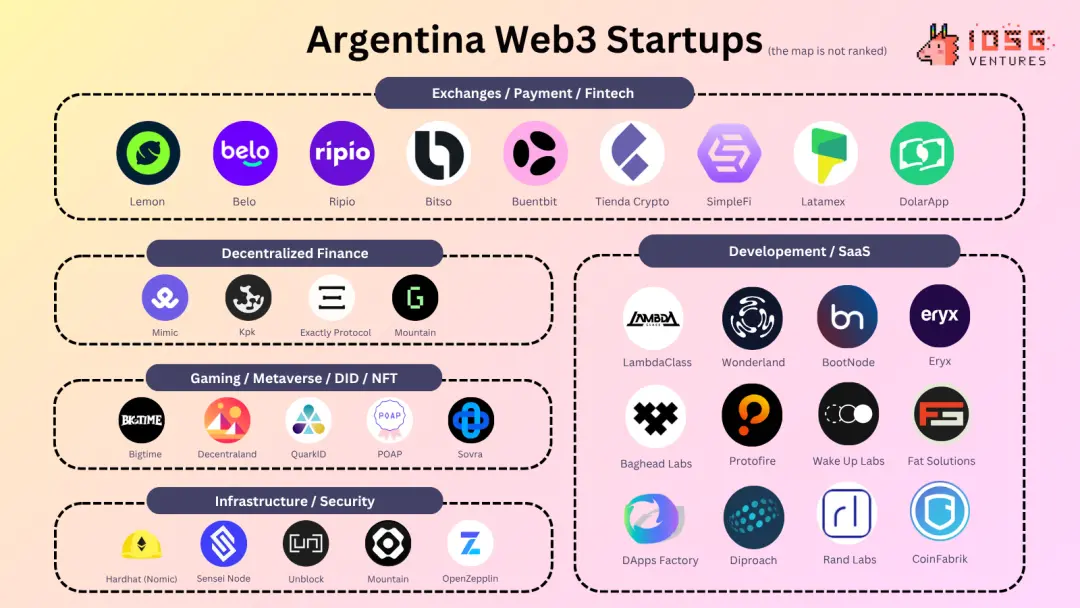
# Cryptocurrency Exchanges, Payments, and Financial Platforms (Fintech)
This is the largest and most dynamic sector, mainly driven by the strong retail adoption of cryptocurrencies, especially stablecoins. Major local players include:
-
Exchanges and wallets: Lemon, Belo, Ripio, Buenbit, Bitso, Tienda Crypto, SimpleFi, Latamex, and DolarApp.
-
International presence: The market also features global exchanges such as Binance, Bybit, and Coinbase.
# Web3 Infrastructure, Development, and SaaS
This sector provides the foundational tools and services needed to build decentralized applications:
-
Infrastructure: Organizations and companies such as Hardhat, Sensei Node, Unblock, and OpenZepplin.
-
Development/SaaS: Numerous specialized development agencies and studios, including LambdaClass, Wonderland, BootNode, Eryx, Rand Labs, Baghead Labs, Protofire, Wake Up Labs, Fat Solutions, CoinFabrik, DAppsFactory, Diproach, Rather Labs, and more.
# Emerging Fields
Local innovation is extending into cutting-edge and specialized application scenarios such as DeFi, gaming, on-chain governance, and NFTs:
-
DeFi: Mimic, Kpk, Exactly Protocol, and Mountain Protocol.
-
Metaverse and gaming: Well-known projects such as Decentraland and Bigtime.
-
Digital identity and on-chain governance: Platforms such as QuarkID, POAP, and Sovra.
The vitality of Argentina’s Web3 startups can be summed up as “market validation” and “technology intensity,” driven by a unique economic environment that has transformed cryptocurrency from an optional speculative asset into a necessary financial tool. This urgency has fostered a highly competitive and innovative environment, resulting in a dual advantage: a strong presence in consumer-facing platforms (such as exchanges and payments) and deep technical strength in infrastructure and innovative decentralized applications (DApps).
Developers and Talent Pool
Argentina is a powerhouse of tech talent in the region, with high-quality, globally competitive developers and engineers who are highly sought after by companies seeking nearshore outsourcing.
# Talent Scale and Quality
Argentina has a robust talent pool, with over 115,000 software developers and about 27,000 new professionals trained each year. Argentine tech talent is considered highly skilled, often matching US standards, and possesses a global mindset. The combination of quality talent and cost advantages makes Argentina an attractive base for development and engineering.
# Web3 Specialization Advantages
Economic turmoil and long-term inflation have instead created unique advantages, fostering a generation of developers who are not only technically proficient but also deeply passionate about the potential of blockchain and cryptocurrency. Developers commonly demonstrate in-demand skills in blockchain languages and frameworks, including Solidity, Rust, Anchor, TypeScript, and Node.js.
Local Community and Innovation Spaces
The developer ecosystem is highly collaborative, centered in Buenos Aires, with frequent blockchain events, workshops, and hackathons. Local activities are often reinforced through structured educational partnerships, such as grassroots movements and communities:
# Crecimiento
-
Core vision: Dedicated to making Argentina a global hub for cryptocurrency and cutting-edge technology innovation.
-
Key contributions: Serves as a connector, bringing together builders, founders, policymakers, and global partners. Organizes high-impact projects (such as the Aleph Hub event series) and actively participates in building regulatory frameworks, such as collaborating with the National Securities Commission (CNV) on tokenization sandbox initiatives.
# Ethereum Argentina & ETHKipu
-
Core vision: Focused on Ethereum ecosystem building, educational outreach, and organizing major events.
-
Key contributions: They lead the annual Ethereum Argentina conference and have successfully brought the Devconnect conference to Buenos Aires.
-
ETHKipu focuses on educational projects, having successfully integrated Ethereum and the Solidity programming language into the Buenos Aires high school curriculum.
# SEED Org
-
Core vision: Promotes decentralized solutions through three pillars: governance, community/education, and infrastructure.
-
Key contributions: Relies on SEED nodes (infrastructure) to stabilize the ecosystem, conducts community education through SEED Latin America, and promotes decentralized decision-making via the SEED governance platform.
# Mujeres en Crypto (MEC) Women in Crypto Organization
-
Core vision: Promotes diversity, equity, and inclusion by fostering women’s participation and leadership in the Web3 ecosystem.
-
Value contribution: The organization hosts events, builds networking platforms, and provides industry resources to open career opportunities for women, while serving as a core community partner for major international events.
# Cultura C3
-
Core philosophy: A passionate tech community dedicated to practicing the values of Creer (believe), Crear (create), and Compartir (share) in the crypto and Web3 space.
-
Value contribution: Regularly hosts workshops and offline gatherings, shares educational content, and often collaborates with mainstream groups such as Ethereum Argentina to expand decentralized opportunities from Buenos Aires to Córdoba and beyond.
This overview is not exhaustive—Argentina’s Web3 ecosystem continues to expand, with numerous outstanding local communities and projects actively driving ecosystem development. We invite all builders and communities committed to advancing Latin America to connect and collaborate.
Investment Trends
Despite the overall Latin American venture capital market being affected by global economic pressures in recent years, Argentina’s Web3 sector continues to attract significant investment, often concentrated in the broader fintech category.
Fintech-Dominated Investment: Fintech remains the leading sector for startup financing in Latin America. Argentina stood out in 2024, with Buenos Aires-based digital bank Ualá completing a $300 million Series E round, setting a record for the largest VC deal in the region. This demonstrates investor confidence in Argentina’s large fintech firms, even if they are not purely crypto-native.
Web3-Specific Financing: Crypto platforms have also secured notable investments from well-known VCs, with fintech and payment-related projects attracting the most attention.
-
Argentine crypto exchange Lemon successfully completed a $20 million Series B round for Latin American expansion, with participation from US funds F-Prime and ParaFi.
-
Leading Latin American crypto service provider Ripio has raised over $50 million in equity, including a $50 million Series B led by DCG in September 2021. Before equity financing, the company raised $37 million in a public offering for Ripio Credit Network (RCN) in 2017.
-
DeFi protocol Kpk (formerly karpatkey) disclosed $7 million in funding in 2024, with investors including Borderless Capital, Wintermute Ventures, as well as angel investors like Joe Lubin and the founder of Aave.
Although the current global VC trend is more cautious, emphasizing thorough due diligence and focusing on founder strength and product-market fit rather than “Web3” as a narrative, Argentina’s Web3 investment landscape is dominated by fintech and payment-related platforms. This reflects a market focus on companies addressing severe economic instability and financial pain points through crypto-financial solutions. Significant capital is flowing to mature local exchanges and service providers such as Lemon and Ripio to promote stablecoin adoption and cross-border payments.
While broad fintech sectors such as digital banks attract the most funding, technically complex on-chain infrastructure solutions are also gaining increasing attention. This suggests a more balanced investment strategy: supporting both scalable consumer financial essentials and the technical foundations for building decentralized ecosystems.
V. Conclusion
Argentina has indisputably become a core testing ground for real-world Web3 applications and innovation globally. The data is clear: from the overwhelming dominance of stablecoins in trading volume to ranking among the world’s top digital asset holders, all evidence shows that cryptocurrency here is a mechanism for economic survival, not just a speculative tool.
As the ecosystem matures, driven by world-class developers and a strong local community, the focus is shifting from basic trading platforms to more complex underlying infrastructure, decentralized finance, and cutting-edge on-chain solutions. Looking ahead, the convergence of mature technical foundations, organically exploding user demand, and the spotlight of the 2025 Buenos Aires Devconnect conference is sure to create unprecedented historic opportunities.
We sincerely invite policymakers, global builders, and investors to view Argentina as a “sandbox” for leveraging the financial future, not merely a speculative market. We call for ongoing deep collaboration with all stakeholders to unlock broader development potential across Latin America.
Recommended reading:
$1.1 billion in stablecoins evaporated: What’s the truth behind the DeFi domino collapse?
MMT short squeeze review: A carefully orchestrated money grab?
Amid brutal harvesting, who is looking forward to the next COAI?
Disclaimer: The content of this article solely reflects the author's opinion and does not represent the platform in any capacity. This article is not intended to serve as a reference for making investment decisions.
You may also like
DYDX Intensifies DEX Rivalry with Strategic Moves
In Brief DYDX launches zero fee initiative to boost on-chain trading platform usage. The move aims to increase user participation and improve DYDX's market dynamics. DYDX faces challenges with declining TVL and user interest amidst market uncertainties.

Stablecoins Could Push the Fed to Reassess Its Monetary Policy

XRP ETF Appear On DTCC : Is Approval Next ?

Digital Asset Funds See $1.17B Outflows Amid Market Uncertainty

